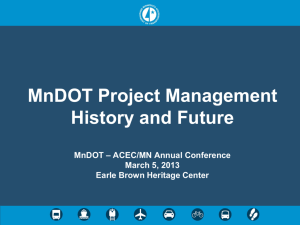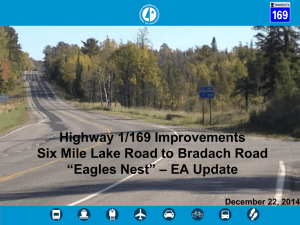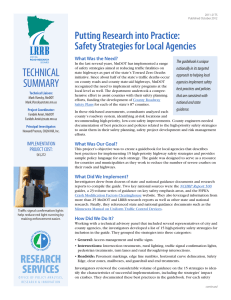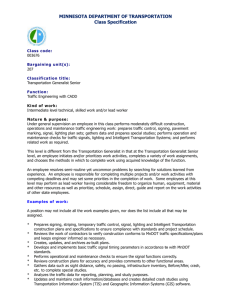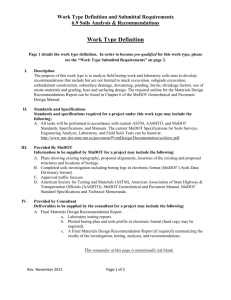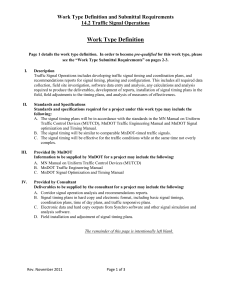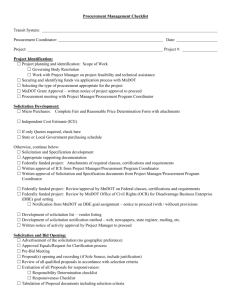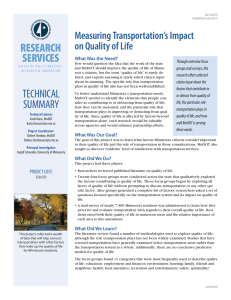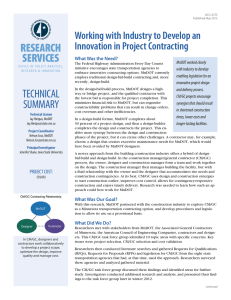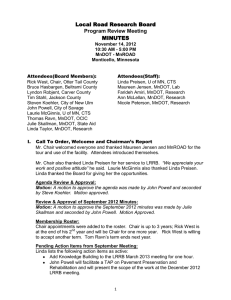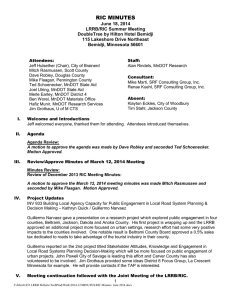TECHNICAL Evaluating Traffic Data Collection Processes and Technologies What Was the Need?
advertisement
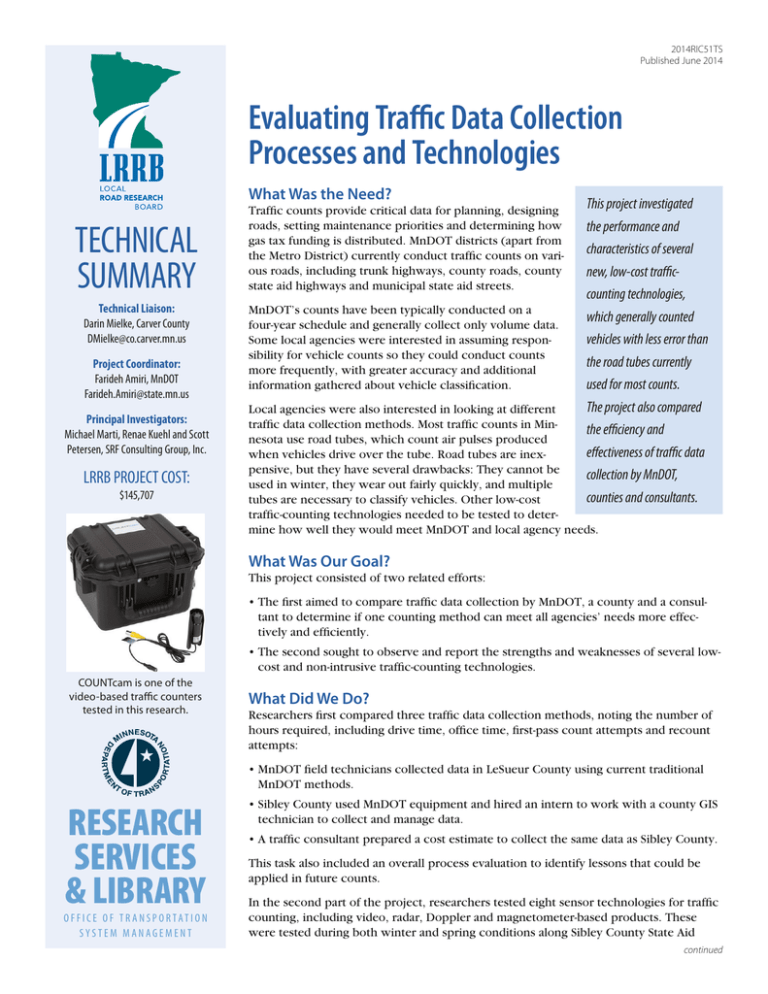
2014RIC51TS Published June 2014 Evaluating Traffic Data Collection Processes and Technologies What Was the Need? TECHNICAL SUMMARY Technical Liaison: Darin Mielke, Carver County DMielke@co.carver.mn.us Project Coordinator: Farideh Amiri, MnDOT Farideh.Amiri@state.mn.us Principal Investigators: Michael Marti, Renae Kuehl and Scott Petersen, SRF Consulting Group, Inc. LRRB PROJECT COST: $145,707 Traffic counts provide critical data for planning, designing roads, setting maintenance priorities and determining how gas tax funding is distributed. MnDOT districts (apart from the Metro District) currently conduct traffic counts on various roads, including trunk highways, county roads, county state aid highways and municipal state aid streets. MnDOT’s counts have been typically conducted on a four-year schedule and generally collect only volume data. Some local agencies were interested in assuming responsibility for vehicle counts so they could conduct counts more frequently, with greater accuracy and additional information gathered about vehicle classification. This project investigated the performance and characteristics of several new, low-cost trafficcounting technologies, which generally counted vehicles with less error than the road tubes currently used for most counts. The project also compared the efficiency and effectiveness of traffic data collection by MnDOT, counties and consultants. Local agencies were also interested in looking at different traffic data collection methods. Most traffic counts in Minnesota use road tubes, which count air pulses produced when vehicles drive over the tube. Road tubes are inexpensive, but they have several drawbacks: They cannot be used in winter, they wear out fairly quickly, and multiple tubes are necessary to classify vehicles. Other low-cost traffic-counting technologies needed to be tested to determine how well they would meet MnDOT and local agency needs. What Was Our Goal? This project consisted of two related efforts: • The first aimed to compare traffic data collection by MnDOT, a county and a consultant to determine if one counting method can meet all agencies’ needs more effectively and efficiently. • The second sought to observe and report the strengths and weaknesses of several lowcost and non-intrusive traffic-counting technologies. COUNTcam is one of the video-based traffic counters tested in this research. What Did We Do? Researchers first compared three traffic data collection methods, noting the number of hours required, including drive time, office time, first-pass count attempts and recount attempts: • MnDOT field technicians collected data in LeSueur County using current traditional MnDOT methods. RESEARCH SERVICES & LIBRARY O FFI C E O F T R A NSP O R TAT I O N SYSTEM MANAGEMENT • Sibley County used MnDOT equipment and hired an intern to work with a county GIS technician to collect and manage data. • A traffic consultant prepared a cost estimate to collect the same data as Sibley County. This task also included an overall process evaluation to identify lessons that could be applied in future counts. In the second part of the project, researchers tested eight sensor technologies for traffic counting, including video, radar, Doppler and magnetometer-based products. These were tested during both winter and spring conditions along Sibley County State Aid continued “Through this process, the state and the counties developed a better understanding of each other’s needs and a better working relationship.” —Michael Marti, Principal, SRF Consulting Group, Inc. “We steered away from providing recommendations about specific traffic-counting products in favor of showing the attributes and capabilities of each sensor for MnDOT and counties to consider as they evaluate their own needs.” —Darin Mielke, Assistant Public Works Director, Carver County Traffic-counting systems, including the JAMAR Radar Recorder, were installed on Sibley County State Aid Highway 9. Unlike road tubes, most of the tested systems are deployed on roadsides, making them safer for personnel to install. Highway 9, a rural two-lane road with low traffic volumes. MnDOT installed a calibrated loop-piezo-piezo-loop automatic traffic recorder to provide baseline data for comparison, although these traffic recorders are too costly for widespread use outside of high-volume roads. What Did We Learn? Researcher observations of each of the traffic-counting products are intended as a guide to help agencies evaluate which choice best meets their needs. The report includes a table that describes each sensor’s communication options, ease of installation, data accuracy and data post-processing capabilities. Apart from one product that was damaged in the field and was not included in the results, each of the sensors tested performed well, with fewer errors than road tubes. In reporting total traffic volume, the tested sensors had error rates ranging from 1.5 to 4.1 percent compared to 6.8 percent for tube counters. The tested sensors had error rates from 4.5 to 14.8 percent in classifying vehicle length compared to 16.5 percent for tube counters. Each of the sensors were rated as “easy” or “very easy” to install and use, although costs ranged from $2,500 to $5,500—significantly more than the $500 cost of road tubes. Additionally, although these were not documented in the final report, several lessons emerged as the participating counties learned about the requirements that MnDOT has faced in collecting and reporting data to receive federal funding. These included the importance of quality training and equipment, adequate staffing for conducting counts, careful planning around construction and other events, efficient data processing procedures and quick data analysis turnaround. What’s Next? The lessons learned in the first part of this project should improve the working relationship between MnDOT and local agencies as they work to meet their traffic data collection needs. Produced by CTC & Associates for: Minnesota Department of Transportation Research Services & Library MS 330, First Floor 395 John Ireland Blvd. St. Paul, MN 55155-1899 651-366-3780 www.mndot.gov/research The second part of the report serves as a current snapshot that will be valuable in future traffic data collection efforts. Traffic data counting technology is rapidly developing, and technologies will need to be evaluated as they come on the market. MnDOT recently funded a follow-up study on the use of low-cost weigh-in-motion technology for vehicle counting, with results likely available in 2015. This Technical Summary pertains to the LRRB-produced Reports 2014RIC51A, “Traffic Data Collection Processes Study,” and 2014RIC51B, “Traffic Data Collection Improvements,” published February 2014. The full reports can be accessed at http://www.lrrb.org/PDF/2014RIC51A.pdf and http://www.lrrb.org/PDF/2014RIC51B.pdf.
